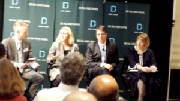In Advance of the News
Just what stories will the news media be covering this
year? Editors develop annual lists that identify important stories by month and date. The lists, or datebooks,
help them with staffing logistics and enable reporters to conduct research, identify angles and write stories in advance of
the event.
Datebooks are, of course, works in
progress, with new items added as the year unfolds. Public relations executives who scan these lists can sometimes figure
out ways in which their clients or companies might play a role in the unfolding and news coverage of these events. That's
true both for internal and external communications.
Here are links to the Wall Street Journal's datebook of global events and datebook of Greater New York published online on January 4. Here (chart, left) also is a combined snapshot from those
datebooks of events occurring in March. We will soon be reading about them in the news.
-- Jeff Bogart
Compliance Chiefs Provide Anticorruption
Insights at Dow Jones Breakfast
"We don't like to
use the term 'whistle blower,'" said Nicholas Elliott, editor, WSJ Risk & Compliance Journal.

His was one of the comments I heard while attending the anticorruption
compliance breakfast held in midtown Manhattan by Dow Jones Risk & Compliance on Feb. 23.
Elliott moderated a panel of chief ethics and compliance officers from Merck &
Co., General Electric, and Bechtel. Here are some of the corporate executives' observations:
-- "Good and effective compliance is local compliance,"
not centrally imposed compliance. We invest locally in it.
-- After reducing our 65-page conduct code by two thirds, "something great happened--employees started
to read it."

- --". . .[W]hen you simplify, you force yourself to hone
in on the why and not the what."
- --
"We need our employees exercising good judgment . . . not simply following a set of rules."
-- We still have 60 pages of code. You cannot just assume that people know
the right thing to do.
--You cannot write rules
that cover every situation; but you can create the expectation of following the rules.
-- A culture of compliance is "far and away"
the most important component of an effective compliance program.
-- A sign of a strong culture of
compliance is when what you ask be done is well received.
-- A second "true sign"
of compliance effectiveness--emphasis on coming forward to report what is seen.
-- If there is quiet among employees, that is "the first important sign of trouble."
--Assess the tone about compliance not only at  the top of the company but also at the bottom among
line workers and first-line management. If it is positive there, "then you're almost home."
the top of the company but also at the bottom among
line workers and first-line management. If it is positive there, "then you're almost home."
--The biggest change in compliance in recent years is a transition from training and education to auditing and monitoring.
-- Another big change in compliance is the use of data analytics to know when to
audit.
-- Jeff Bogart




 the top of the company but also at the bottom among
line workers and first-line management. If it is positive there, "then you're almost home."
the top of the company but also at the bottom among
line workers and first-line management. If it is positive there, "then you're almost home."

